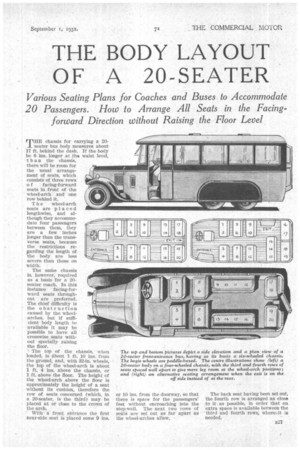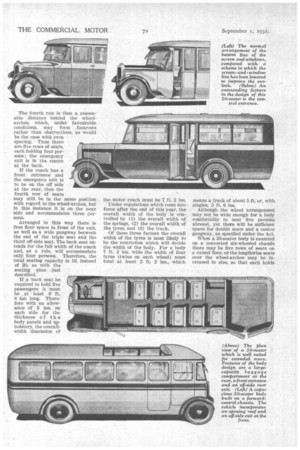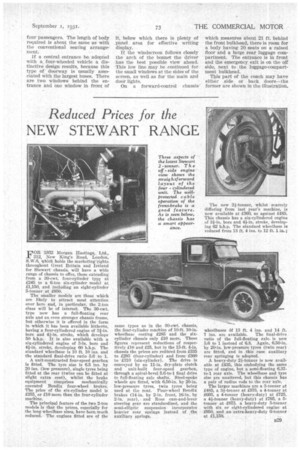THE BODY LAYOUT
Page 45

Page 46

Page 47

If you've noticed an error in this article please click here to report it so we can fix it.
OF A 20-SEATER
Various Seating Plans for Coaches and Buses to Accommodate 20 Passengers. How to Arrange All Seats in the Facing. forward Direction without Raising the Floor Level
T h e wheel-arch seats are placed lengthwise, and although they accommodate four passengers between them, they are a few inches longer than the transverse seats, because the restrictions regarding the length of The body are less severe than those on The same chassis is, however, required as a basis for a 20seater coach. In this instance facing-forward seats throughout are preferred. The chief difficulty is the obstruction caused by the wheelarches, but if sufficient body length be available it may be possible to have all crosswise seats without specially raising the floor.
" The top of the chassis, when loaded, is about 1 ft. 10 ins, from the ground, and, with 32-in, wheels, the top of the wheel-arch is about 1 ft. 4 ins, above the chassis, or 1 ft. above the floor. The height of the wheel-arch above the floor is approximately the height of a seat without its cushion, therefore the row of seats concerned (which, in a 20-seater, is the third) may be placed at or close to the crown of the arch.
With a front entrance the first near-side seat is placed some 9 ins.
or 10 ins, from the doorway, so that there is space for the passengers' feet without encroaching into the step-well. The next two rows of .seats are set out as far apart as the wheel-arches allow.
The back seat having been set out, the fourth row is arranged as close to it as possible, in order that an extra space is available between the third and fourth rows, where%it is needed.
The fourth row is then a reasonable distance behind the wheelarches, which, under favourable conditions, may form footrests rather than obstructions, as would be the case with even spacing. Thus there are five rows of seats, each holding four persons; the emergency exit is in the centre at the back.
If the coach has a front entrance and the emergency exit is to be on the off side at the . rear, then the fourth row of seats may still be in the same position with regard to the wheel-arches, but in this instance it is on the near side and accommodates three persons.
Arranged In this way there is free floor space in front of the exit, as well as a wide gangway between the end of the triple seat and the third off-side seat. The back seat extends for the full width of the coach and, as a rule, will accommodate only four persons. Therefore, the total seating capacity is 19, instead of 20, as with the seating plan just described
If a back seat be required to hold five passengers it must be at least 6 ft. 8 ins. long. Therefore with an allowance of 3 ins, on each side for the thickness of the body panels and upholstery, the overallwidth dimension of
the motor coach must be 7 ft. 2 ins.
Under regulations which come into • force after the end of this year, the overall width of the body is controlled by (1) the overall width of the springs, (2) the overall width of the tyres, and (3) the track.
Of these three factors the overall width of the tyres is most likely to be the restriction which will decide the width of the body. For a body 7 ft. 2 ins, wide the width of four tyres (twins on each wheel) must total at least 2 ft. 2 ins., which means a track of about 5 ft. or, with singles. 5 ft. 6 ins, Although the wheel arrangement may not be wide enough for a body comfortably to seat five personS abreast, yet there will be sufficient space for double seats and a centre gangway, as specified tinder the Act.
When a 20-seater body Is mounted on a converted six-wheeled chassis there may be five rows of seats on a raised floor, or the lengthwise seats over the wheel-arches may be increased in size, so that each holds four passengers. The length of body required is about the same as with the conventional seating arrangement.
If a central entrance be adopted with a four-wheeled vehicle a distinctive design results, because this type of doorway is usually associated with the largest buses. There are two windows behind the entrance and one window in front of it, below which there Is plenty of panel area for effective writing display.
If the windscreen follows closely the arch of the bonnet the driver has the best possible view ahead. This low line may be continued for the small windows at the sides of the screen, as well as for the main a.nd door lights.
On a forward-control chassis'
which measures about 21 ft. behind the front bulkhead, there is room for a body having 20 seats on a raised floor and a large rear luggage compartment. The entrance is in front and the emergency, exit is on the off side, next to the luggage-compartment bulkhead.
This part of the coach may have either side or back doors—the former are shown in the illustration.




































































































